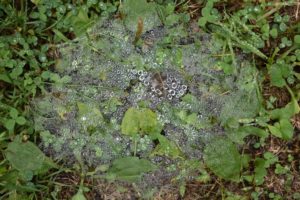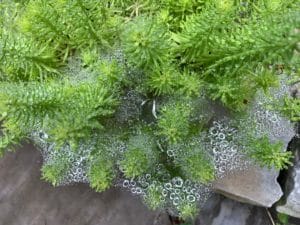Hello fellow readers, Have you noticed on a humid summer morning, sometimes there are shiny clusters of droplets on what looks like cobwebs in the lawn? The webs could be the branching nature of dollar spot fungus. Or, they may be the webs of grass spiders. Then there are the adorable droplets on Lady’s Mantle and other plants creating what’s called a lotus effect.
What can encourage Dollar Spot?
When a lawn is stressed, from being cut too short, from drought or overwatering, or poor aeration caused by too much thatch, warm days and cool nights can encourage dollar spot. It’s so-called as it causes silver dollar sized brown spots in the lawn. The spots can grow into much larger irregular shapes making the grass look dry.
To prevent the fungus, keep the proper mowing height of three inches, water weekly if Mother Nature does not, and de-thatch if needed.
Glistening Droplets on Lady’s Mantle
Speaking of droplets– there’s more to gardens than the textures of leaves, heights of plants, and colors of blooms. There’s the attraction of bark and stems, and how some flowers and plants are beautiful when dry or dormant. Another delight is how some plants capture the morning dew with droplets that glisten in the morning sun. Like Lady’s Mantle, Alchemilla mollis, one of my favorites.
My Lady’s Mantle came from a dear friend and designer colleague Marty Carson of Three Seasons Inc. They’ve self-seeded in the nooks and crannies of the natural stone walkway, which I adore— staying miniature in size and softening the path. The leaves are fan-shaped with tiny teeth at the tips. Though admired mostly for foliage, chartreuse petal-less clusters of flowers adorn her from spring into summer.
What is the lotus effect?
Upon close inspection, you’ll notice Lady’s Mantle leaves have tiny soft hairs which “show a high degree of water resistance,” writes Wikipedia calling it a lotus effect, a concept new to me. Lotus effect is also known as superhydrophobicity. Like lotus leaves, Lady’s Mantle doesn’t absorb wetness easily and hold droplets of water that cleans dirt from leaves. And it seems the reverse is true, that the leaves don’t dehydrate readily. In the heat of the summer, despite being tucked between the hot stones, they are no worse for the wear.
In addition to Lady’s Mantle, there’s Nasturtium (Tropaeolum) and Prickly Pear (Optunia) and the wings of insects such as butterflies and dragonflies that sport the lotus effect. The perfect spherical droplets left after a rain or morning dew are eye-catching and oh so charming in the garden.
Dollar Spot or Grass Spiders?
Interestingly my lime green sedum (Sedum rupestre ‘Angelina’) was sporting droplets on webs the other morning, which I marveled over. As it turns out, it could be grass spiders (Agelenopsis) that are the culprit. The same is true if your lawn has cobwebs but doesn’t result in the classic brown spots.
Grass spider webs are more cone-shaped than dollar spot. Let them be and enjoy the shiny morning droplets as the beneficial spiders feed on insects in the lawn.
Garden Dilemmas? AskMaryStone@gmail.com (and now on your favorite Podcast App).
You’ll enjoy a previous column on a mysterious lawn fungus titled Fairy Rings.
More about Lady’s Mantle




